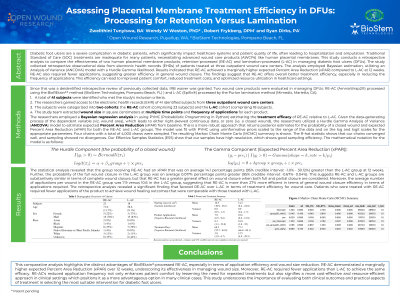Clinical Research
(CR-023) Assessing Treatment Efficiency in Diabetic Foot Ulcers: Processing for Retention Versus Lamination: A Retrospective Analysis
Thursday, May 16, 2024
7:30 PM - 8:30 PM East Coast USA Time

Zwelithini Tunyiswa, BA – Chief Executive Officer, Open Wound Research; Wendy Weston, PhD, CTBS – VP Research and Development, BioStem Technologies
Introduction: Diabetic foot ulcers area severe complication in diabetic patients that significantly impact healthcare systems and patient quality of life, often leading to hospitalization and amputation. Traditional Standard of Care (SOC) treatments are inadequate for many patients, necessitating advanced wound care products (AWCPs), like human placental membranes. This study conducts a retrospective analysis to compare the effectiveness of two human placental membrane products, retention-processed (RE-AC) and lamination-processed (L-AC) in managing chronic wounds, particularly diabetic foot ulcers (DFUs).
Methods: The study collected retrospective observational data from electronic health records (EHRs) of patients treated at three outpatient wound care centers. Patients were categorized into two cohorts based on the treatment received. Key metrics included wound size progression and the number of product applications. The analysis employed Bayesian regression and Hurdle Gamma Analysis of Variance (ANCOVA) models.
Results: Results indicated that RE-AC achieved a higher expected Percent Area Reduction (xPAR) compared to L-AC at 12 weeks. RE-AC also required fewer applications, suggesting greater efficiency in general wound closure.
Discussion: The findings suggest that while L-AC might be slightly more effective in complete wound closure, RE-AC offers overall better treatment efficiency, especially in reducing the frequency of applications. This efficiency can lead to improved patient comfort, reduced treatment costs, and optimized resource utilization in healthcare settings.
Methods: The study collected retrospective observational data from electronic health records (EHRs) of patients treated at three outpatient wound care centers. Patients were categorized into two cohorts based on the treatment received. Key metrics included wound size progression and the number of product applications. The analysis employed Bayesian regression and Hurdle Gamma Analysis of Variance (ANCOVA) models.
Results: Results indicated that RE-AC achieved a higher expected Percent Area Reduction (xPAR) compared to L-AC at 12 weeks. RE-AC also required fewer applications, suggesting greater efficiency in general wound closure.
Discussion: The findings suggest that while L-AC might be slightly more effective in complete wound closure, RE-AC offers overall better treatment efficiency, especially in reducing the frequency of applications. This efficiency can lead to improved patient comfort, reduced treatment costs, and optimized resource utilization in healthcare settings.

.jpeg)